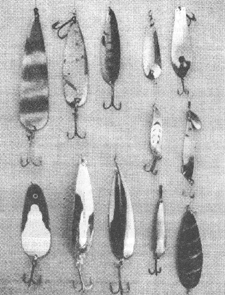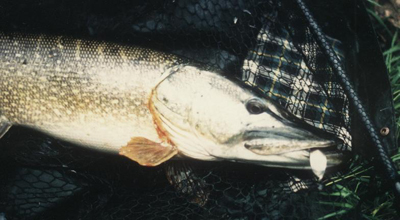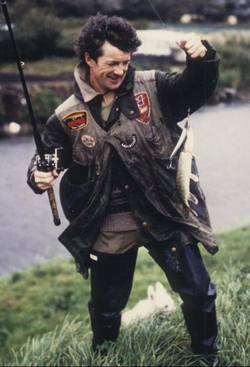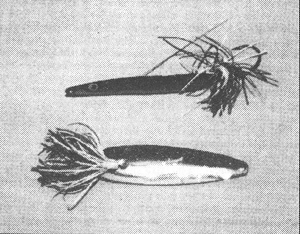[14]
SPOONS
Spoons are quite possibly the most basic of lures.
Let's face it, all they are, at their simplest,
is a piece of stamped sheet metal. It is, perhaps,
for this reason that they are often overlooked.
The biggest problem most people have with spoons
is the fact that they sink, and because they sink
they are excellent for locating snags. Luckily
they are relatively inexpensive, so it is my policy
to buy spoons in threes of a kind. At least I
know that I will have a direct replacement for
a spoon that is catching should I lose it. This
will save me rooting about trying to find a suitable
alternative that might not appeal to the pike.
I have already mentioned the instance when the
only spoon I could get takes on was a 28g Toby
in zebra pattern, and the fact that my boat partner
was catching on a silver version of the same lure
was most interesting, notably because my efforts
with a silver Toby failed.
There
are three main colours for spoons; silver, brass
and copper. For once I actually rate copper
as a lure colour when it comes to spoons, but
still place silver as my number one. Brass or
gold is my second favourite. There are now many
coloured spoons in the shops too. In the past
the classic painted patterns were the red and
white stripe, and the yellow with red five-of-diamonds.
The red and white is a classic pike taker, but
then it is silver on the concave side! Today's
excellent patterns, I feel sure catch more anglers
than pike. I fail to see how a pike can detect
the details painted on to one side of a spoon
when they are continually 'flashing' on and
off as the spoon wobbles along. I may be wrong
here, but I don't think so. having one side
of a spoon painted will, though, give a muted
effect to its opposite side, and some patterns
will offer a high contrast flash. Either of
these two contradictory effects might just make
for the lure the pike want on any particular
day. Having said all this I have caught a lot
of fish on pike and perch patterned brass spoons.
I guess a plain spoon might have done just as
well!
I
have mentioned the Abu Toby and it is a most
useful lure, rather smaller than I would like
but this, coupled with its density makes it
such a good casting lure. It cuts into the wind
like few other spoons, and will reach pike that
other lures can't. This feature is of most use
to bank based anglers, but can be beneficial
to boat anglers too - reaching into nature reserves
for example! The profile of the Toby also ensures
that it will continue to stay fairly deep when
other spoons would have planed to the surface.
Originally designed as a salmon lure, the Toby
is intended for use in running water where its
deep running potential can be most welcome.
There are many copies of the Toby available,
often at quite a saving. Some are not quite
so good, but most match up well. The Toby Salmo,
at 30g, is heavier than the heaviest standard
Toby, but being wider doesn't cast so well or
fish as deeply. When I want a larger lure than
the Toby, but still want to fish deep or at
distance I go for the Landa Longa in the 35g
size, at 4 inches it is also wider than the
Toby and so looks a lot bigger. There are some
other good spoons for long casting from Kilty,
who do some real monsters suitable for deep
trolling too, and Gordon Griffiths. Both these
firms are primarily game orientated and salmon
anglers use a lot of spoons, although their
needs are different to those of most pike anglers.

Top row left to right: Kilty Heron (repainted),
7". Gordon Griffiths Atlantic Trolling Spoon,
5½". Landa Longa. Traditional spoon of
unknown make. Kuusamo Professor.
Middle row: Mepps Syclops. Landa Lukki
Flipz.
Bottom row: Lindy Gator Spoon. Williams
Whitefish. Griffiths Lightweight spoon. Abu
Toby. Home-made copper spoon fitted with Easi
Links.Landa
also make a variant on the Toby theme, the Lukki,
which is available in a 35g version which is
the same length and shape as its 28g stablemate.
You can imagine how this one casts! Tony Perrin
(Mr. Landa) has produced some nice spoons and
his Lukki Flipz, a Lukki with a spinner attached
to the front, is another variation on the spoon
theme. I am not sure if this lure is still available,
but can be easily created by adding a Flipz-On
to the front of a Lukki. Landa market two blade
mounts with quick change clevises and four blades
in a packet to allow you to so just that. Spinner-spoons,
as the combination is imaginatively called,
give better casting than plain spinners, deeper
running depth and a larger bait. There is more
throb and flash than you get from a plain spoon
too. Like the weight forward spinner, the spinner-spoon
is an overlooked lure.
It might seem strange to refer to sinking lures
as running at different depths, but it is a
fact that some spoons fish deeper than others.
Strictly speaking this will depend upon a number
of other factors, again similar to those that
apply to spinners. Wide spoons made from thin
gauge material fish shallower than narrow spoons
made from thick metal sheet. Most spoon manufacturers
produce their baits in this way, with two or
three weights for each size of lure. Then to
give a further range there will be longer, slimmer
baits and even shorter, broader baits. The most
comprehensive selection I can think of is the
Dardevle range from the 'States. At present
only a limited selection of these spoons is
available in the U.K. Landa in the U.K. also
have a pretty good selection enabling the dedicated
spoon angler to cover many eventualities. As
a guide, broader spoons have a wider wobble
than slimmer models stamped from the same gauge
of sheet metal, and a much more noticeable thumping
throb as you retrieve it. And similarly shaped
lures stamped from thin and thick sheet will
have slightly wider and narrower wobbles respectively.
There are a number of common spoon shapes, and
a few uncommon ones too. My preference is for
the slimmer versions of the traditional dished
spoon shape. These and the Toby type with its
obvious 'S' curve. The Kuusamo Professor is
more or less a big, broad version of the Toby,
but lacking the 'S' curve and flaring out again
at the thin end. The Professor is very similar
to the Arbogast Doctor spoon.

A Mepps Syclops fished high over a depth of
twelve feet accounted for this clear-water
gravel pit pike.
One of the prime uses for spoons is to fish
deep water. You can use them to find the taking
depth that pike are feeding at too. The much
talked about countdown technique is the one
to use, in conjunction with a spoon that maintains
its depth. A wide, thin spoon is not much use
for this tactic as it will plane up to the surface
far too quickly. To count a spoon down, or any
sinking lure in fact, simply cast it out and
as it sinks count steadily (out loud if you
must!). This will give you a number that equates
to the depth of the water. Let's say it is ten.
Try starting the retrieve when you reach nine
as you count down the next cast. If you get
a take having started the retrieve at five,
then the pike are somewhere near mid-water.
This information might help you as you move
around the water, as you can start fishing your
lures at the count of five reducing wasted time
fishing deeper in each new swim. of course the
pike might easily be lying deeper in different
areas, but there is every chance that they are
not. Occasionally you might find that spoons
are taken on the drop, and this is most noticeable
when counting them down. If you are letting
the lure sink on a tight line, which admittedly
brings it in closer to you, most noticeably
so in deep water, then you will feel the take.
Either the lure will seem to hit bottom too
soon, or you will feel the pike thump the spoon.
Strike! If the lure is falling on a slack line
then you must watch it where it enters the water.
Watch closely for any untoward movement, this
will be a take. If the line stops pulling off
the reel before the lure hits bottom, a pike
has taken the lure, similarly if it moves to
one side or the other. When you are counting
the lure down without paying attention the take
will be felt as soon as you start the retrieve,
as something pulling back!
Fishing
spoons in shallow water, less than ten feet,
doesn't usually require you to count the lure
down as pike will either be prepared to come
up to take it, or will want it tripped just
off bottom if they are lethargic. In this sort
of depth most spoons can be used to good effect,
as speed control will be easy enough to keep
the spoon working off the bottom and away from
any major snags. In really shallow water, three
feet or less, heavy and medium gauge spoons
will need to be retrieved fairly quickly to
keep them up, which might not be what the pike
want. This is where lightweight and weedless
spoons come into their own. Flutter spoons are
made from very thin sheet metal which helps
give them a lot of lift and, as their name suggests,
a wide, fluttering action. These spoons are
one of my favourites, probably because a lot
of my local pike waters are relatively shallow.
Being light and having a high lift factor it
is possible to work flutter spoons very slowly.
The one I use most commonly is the Landa Longa
in its 20g size which is 4 inches long. I have
also a larger spoon at 5« inches that
weighs just 5g more. Except with a following
wind or in dead still air these spoons are tricky
to cast on baitcasting gear, and you might find
a fixed-spool is a better bet. No matter what
outfit you go for you won't be able to cast
any great distance and accuracy is not guaranteed
as these lightweight spoons catch the wind and
have little dynamic stability. This property
is actually what gives them their attractive,
wide wobble in the water.
Spoons
have accounted for a number of large trout-water
pike, on some tripped slowly along the bottom,
on others worked high in the water. At times
a spoon worked quickly, close to the surface
can be just what the pike are looking for. Fishing
in this way you can cover a lot of water very
speedily, and with an excellent chance of connecting
with any pike that hits your spoon.

Gord
Burton with proof positive that big lures
don't eliminate the possibility of small pike
having a go. If the spoon hadn't been fitted
with a treble at each end this tiny pike probably
wouldn't have got hooked.
What Tobies and Longas have in common is an
elongated shape. This makes them good hookers
as the spoon will be unlikely to mask the hook
in any way. Broader spoons might, therefore,
require a larger hook. A good rule of thumb
is that the treble should be wider than the
widest part of the spoon. Long spoons, such
as the Longa and longer (pardon the pun) might
also benefit from the addition of a second treble
to the front of the lure. This is done as standard
on the some of the Kuusamo Professors and is
worth trying on similar length lures. Part of
the reason for the two hooks on a Professor
is that the lure is designed to be fished either
way around. But adding a second treble has hooked
me the odd extra pike on other spoons. Generally,
though, spoons hook well. No doubt because they
slip through a pike's jaws easily on the strike,
and even if grabbed across the middle the treble
should slide into a reasonable hook hold in
the scissors.
With
all lures there is the perennial problem of
fish coming short. One solution that has been
put forward is the so called Commando hook.
This is a free flying treble wired to the original
hook on the lure, an inch or three behind it,
a bit like a stinger on a spinnerbait. Another
possible answer is to do as the salmon anglers
do, and remove the original treble and reattach
it with two split rings instead of one. This
places it slightly further behind the lure,
and nearer the pike. With a bit of luck.
Some
spoons come ready kitted out with a small piece
of coloured plastic either on the hook or its
split ring. This small added attractor rarely
lasts long, even if you don't catch anything.
At the risk of giving your spoon more lift you
could add a dressed treble. Sea fishing muppets
work quite well, add some strands of fly-dressing
material or wool, or even the hook from a bucktail
spinner. Adding wool or other materials to a
treble is simplicity itself. Cut the stuff to
twice the length you want it to end up and pass
a small bunch of it through the eye of the hook.
Even it all out and slide a short length of
clear silicone tubing over the eye and down
the shank of the treble, holding the wool or
whatever in place. If this line of attack takes
your fancy it might be worth fitting your spoons
with quick change split rings. Originally designed
for sea fishing applications, I have found Mustad
Easi-Links ideal for use on larger spoons. As
they allow quick changing of trebles it is possible
to carry a load of hookless spoons in a pocket,
and just a few hooks in a small box. This cuts
down on tangles and bulk.
Fishing
spoons is quite simple. You can cast them out
and crank them back at a variety of speeds,
but note that different spoons will have differing
optimum speeds. Some work best fished fast,
and some slower. Try a few casts along the margins
to see what the lure is doing at various speeds.
A straight retrieve will work well for active
fish and should result in good hookups. For
less active fish it pays to vary the retrieve
and start twitching the rod to give the spoon
a more erratic action. This will, in most cases,
widen its action covering a broader swathe of
water. It will also slow the lure's forward
speed, giving pike more time to make up their
minds. When you drop the rod tip and give a
little slack to many spoons they appear to fall
back along their track. Use this trick if a
pike is following close behind. You never know,
it might just open its mouth and inhale the
lure. I liken spoon fishing to wobbling a deadbait.
The retrieves are so similar, it's just that
spoons are fished that bit quicker.
Spoons
are one of the few lures that it is fairly easy
to make for yourself. All that is needed is
some sheet metal, a pair of tin snips, a drill
and a ball pein hammer. Making your own spoons
enables you to produce larger baits than might
be commercially available, and to save a fair
amount of money. You also don't mind fishing
a home made spoon close to snags when you know
how little it has cost! Handmade spoons might
not look as good to our eyes, but flickering
through the pike's watery world is another matter.
So long as they flash and wobble they will catch
pike.
But
do they have to be highly polished to succeed?
Almost every time you read about spoon fishing
you are told to carry something to put the shine
back on your spoons. I admit that there are
times when a flashy lure will out-perform a
dull one, and not just with spoons, but it is
not always so. I have caught pike on extremely
dull copper spoons that haven't been polished
for years. I also remember Dave Scarff telling
me of his preference for spoons plated with
real silver as they were not as bright as chrome
plated lures. I think he had a point there.
Don't get blinkered in your approach. Try to
learn the times to shine your spoons, and those
to leave well alone.
There
is another type of spoon, that behaves completely
differently to the standard baits. This is the
weedless spoon. Most spoons come back flipping
and flopping through the water, only spinning
if retrieved too quickly. Weedless spoons are
designed to fish with the concave face and rigidly
mounted single hook uppermost, rocking from
side to side. Lighter versions of these spoons
can actually be fished on the surface, a little
like a stickbait. The big drawback to weedless
spoons is that they are almost as good at avoiding
hooking pike as they are at avoiding hooking
up on weed! This is down to the weed guard in
part, but mostly the way the hook is firmly
attached to the rear of the spoon. For a prime
example of this watch the Barrie Rickards "Success
With The Lure" video and see a big pike come
adrift on a Heddon Moss Boss, a plastic weedless
spoon - if that makes sense.
Weedless
spoons can be fished in much the same way as
standard spoons, but remember that they quickly
plane to the surface, which is why they are
often heavy lures. You can get away with a one
ounce weedless spoon in water so shallow that
a standard spoon of the same weight would be
dragging bottom. Like all so called weedless
baits these spoons are best suited to avoiding
the attentions of reed stems, branches and such
like, rather than Canadian pondweed or silkweed.
Cast upstream, or up-wind, they will come back
cleanly through the fronds of streamer weed,
but then so will many non-weedless lures. Working
a weedless spoon in lily pads can produce explosive
takes, but because of the tough rhizomes use
stronger than usual tackle. This obviously applies
to all fishing around snags.

Traditional spoons turned weedless.
For
the majority of spoon fishing in open water
with baits up to 1oz lines of 12 to 18 lb
test are perfectly adequate but for weed fishing
step up to 25lb or more. This might lose you
a little distance, but pike in cover will
be less easily spooked and allow you to get
in close. Light weight spoons, are best fished
on fixed spool outfits especially when aiming
for maximum distance. A 28g Toby can be cast
seventy yards or more on 12lb mono from a
small fixed spool on a ten foot spinning rod.
The action of the rod can be quite tippy,
this will certainly help set the hooks if
takes are coming at range. Fixed spool reels
also have a big advantage over baitcasters
when trying to fish spoons in strong winds,
unless extremely heavy/dense baits are being
used. Even so my preference is for a baitcaster
the size of Abu's 5501 matched to a rod of
6½ft to 8ft for my spoon fishing. Admittedly
it limits my choice of spoon to good casting
lures most of the time, but I can live with
that.



